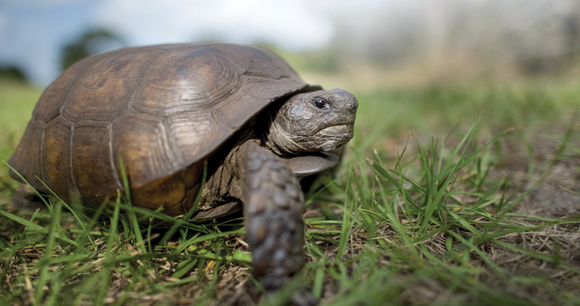by Tracey Tuberville and Rebecca McKee, University of Georgia
Due to many anthropogenic threats, the gopher tortoise is declining throughout its range in the southeastern United States. Translocation—the movement of animals from one location to another—has become an increasingly important tool for mitigating impacts of development and augmenting depleted populations. Although there are risks associated with translocation, waif tortoises (animals that have been injured, collected illegally, or have unknown origins) are generally excluded from translocations due to heightened concerns of introducing diseases into recipient populations. If risks associated with waif translocation to wild habitats could be managed, translocation could provide a preferable alternative to the current fate of many waif tortoises: euthanasia or a lifetime (which can exceed 60 years) in captivity, while also helping to stabilize wild populations in severe decline. In collaboration with the South Carolina Department of Natural Resources, and through support from an AWI Christine Stevens Wildlife Award, we evaluated the survivorship, health, and site fidelity (the tendency to remain in the same area) of released waifs to better understand their role in tortoise conservation and the extent to which formerly captive tortoises are suitable for release into the wild.

Over 280 gopher tortoises had been released on a South Carolina preserve between 2006 and 2018 using soft-release (acclimation) pens to encourage site fidelity (by restricting their movements as they become familiar with the release site). Based on individuals documented in 2017 and 2018, adult annual survivorship of released waif tortoises was 90–96 percent, which is within the range of values reported for wild translocated tortoises and wild tortoises in natural populations. As expected based on the ecology of the species, annual survival of juveniles was lower, but there are few estimates from wild populations with which to compare our data.
Based on the locations where individuals were detected in 2017 and 2018 in comparison to their original release location, we were able to calculate dispersal distances as a measure of site fidelity. We found that waif tortoises, including some released more than a decade prior to our monitoring effort, exhibited remarkable fidelity to their release location. Most individuals detected across the preserve were found within 200–400 meters (⅛–¼ mile) of their original release location.
In regard to disease transmission, after screening for a suite of pathogens common in either captive or free-ranging populations of turtles, we only detected two closely related bacterial pathogens (Mycoplasma agassizii and M. testudineum), which occurred in approximately 10 percent of tortoises. Both pathogens have been documented in wild populations of gopher tortoises throughout the species’ range, with wide variation of prevalence among populations. We did not detect any pathogens typically associated with non-native tortoise species.
Collectively, the survivorship, site fidelity, and health data obtained from 2017–2018 monitoring data reveal that waif gopher tortoises fare well after release into the wild, offering a humane alternative to life-long captivity or euthanasia, while also contributing to meaningful species conservation efforts.
However, because of the potential inherent risks for pathogen transfer, we recommend exercising caution by only using waifs to rebuild small populations that are spatially isolated from other naturally occurring populations.